Author Archive
Following is an excerpt from a report in Expressbuzz.com.
The State Government has decided to elevate Khallikote Autonomous College here and Gangadhar Meher College at Sambalpur to unitary university status, said Higher Education Minister Debi Prasad Mishra here today.
A government appointed task force on higher education reforms had suggested upgrading these two premier autonomous colleges to university status, the Minister said while addressing a function of the Students’ Union of Khallikote College.
Mishra however stressed the need to develop necessary infrastructure facilities before the second oldest college of the State was declared a unitary university.
While at least 50 acre was required, Khallikote Autonomous College had only 16.74 acres of land in its possession.
“There is a proposal to get another 2.50 acres from transport departments garage adjoining the college”, he said.
The Minister asked the local MLAs to locate another 50 acres in the town for the college’s expansion. He also assured the students to fill up the vacant posts soon. Around 50 out of 90 posts of teaching staff are vacant in the 132-yearold college, where over 3,600 students are pursuing studies in 19 different departments, 15 of them having post-graduate departments.
November 20th, 2010
Following is from a PIB release of November 19th 2010.
Nursing Colleges
The following are the steps taken/proposed by the Government: –
i) In order to update knowledge and skills of nursing personnel, assistance is provided for continuing nursing education programme in various specialty areas. This assistance is raised from Rs. 75000/- to Rs. 1.65 lakh per course during XI plan period.
ii) In order to increase the availability of graduate nurses assistance is provided to states for upgradation of schools of nursing into colleges of nursing. This assistance has been increased from Rs. 1.50 crores to Rs. 6.00 crores per institution during XI plan period.
iii) Assistance of Rs. 25.00 lakhs per nursing institution is provided to states for the strengthening of nursing schools/ colleges towards procurement of Audio Visual System, improvement of library, furniture, additions and alterations of hostel building.
iv) Grant of Rs. 1.00 crore has been provided to selected Nursing Council and Cell in states for strengthening and upgradation of nursing services.
v) M.Sc. section has been established for faculty development of Government sponsored candidates from high focused states in 5 Nursing Colleges. Annually 60 candidates per year would get trained to join as faculty in School/Colleges of Nursing in high focus states.
vi) Establishment of 132 Auxiliary Nurse Midwifery (ANM) and 137 General Nursing and Midwifery (GNM) schools in Government Sector in those districts which are not having ANM and GNM training Schools.
vii) Establishment of 6 Colleges of Nursing at the sites of AIIMS like institutions.
viii) Indian Nursing Council has also taken proactive measures to encourage opening of more nursing institutions (Annexure).
Proposals have been received from 6 high focus states namely Arunachal Pradesh, Bihar, Jammu & Kashmir, Orissa, Rajasthan and Uttarakhand for opening of schools of nursing during the current year. No proposal has been received from the Government of Uttar Pradesh. Grant of Rs. 98.50 crores has been provided to the State Governments for opening of 43 such institutions. The detail is as given below: –
|
S. No.
|
State
|
No. of Institution
|
|
1.
|
J&K
|
11
|
|
2.
|
Arunachal Pradesh
|
4
|
|
3.
|
Bihar
|
14
|
|
4.
|
Orissa
|
3
|
|
5.
|
Rajasthan
|
2
|
|
6.
|
Uttarakhand
|
9
|
|
|
Total
|
43
|
PROACTIVE MEASURES TAKEN BY INDIAN NURSING COUNCIL TO ENCOURAGE OPENING OF MORE NURSING INSTITUTIONS
(i) Student patient ratio has been relaxed from 1:5 to 1:3
(ii) The land from 5 acres has been relaxed to construct building of 54,000 sq. ft. for School/College of Nursing and Hostel.
(iii) Relaxed norms for teaching faculty to start B.Sc. (N) Programme.
· At least 2 M.Sc. (N) faculty to be available
· Qualification and Experience of the Nursing Teachers has been relaxed up to 2012.
· Sharing of teaching faculty for both Diploma and Graduate Programme.
(iv) Relaxation for opening M.Sc. (N) programme. Super specialty Hospital can start M.Sc. (N) without having under graduate programme.
i. Relaxation of student teacher ratio for M.Sc (N) programme has been relaxed from 1:5 to 1:10
ii. Essentiality certificate to open M.Sc. (N) programme from State Government is not required for those institution which are already having Indian Nursing Council recognized programme like Diploma or Degree.
iii. If an institution is having INC recognition for one programme then there is no need to have Essentiality Certificate for starting another nursing programme.
(v) Admission for Nursing allowed for married candidates.
(vi) Age increased for Teaching Faculty up to 70 years
(vii) Maximum of 100 seats will be given to those parent hospitals with 300 beds without insisting Medical College
(viii) Distance from school to hospital has been relaxed from 15 km to 30 km
(ix) Eligibility Criteria to admission i.e. (Marks) for Diploma and Degree has been relaxed 5% (GNM – 40%, B.Sc. – 45%).
This information was given by Minister for Health and Family Welfare Shri Ghulam Nabi Azad in written reply to a question raised in Lok Sabha today.
DS/GK
November 19th, 2010
Following is from http://pib.nic.in/newsite/PrintRelease.aspx?relid=67316.
Press Information Bureau
Government of India
Ministry of Human Resource Development
19-November-2010 17:27 IST
Setting up of New IIITs
The Government of India has a proposal to set up 20 new Indian Institutes of Information Technology (IITs) in Public Private Partnership (PPP) mode. The proposal has been approved by the Expenditure Finance Committee (EFC). The locations and other details of new IIITs will depend upon the response of the State Governments & Industry partners.
This information was given by the Minister of State for Human Resource Development, Smt. D. Purandeswari, in written reply to a question, in the Rajya Sabha today.
MV/SKS/Hb
November 19th, 2010
Following is an excerpt from a report in Telegraph.
The proposed institutions are: Vedanta University at Puri-Konark marine drive, Sri Sri Ravi Shankar University at Naraj in Cuttack, Institute of Charted Financial Analysts of India (Icfai) University in Bhubaneswar and Centurion University of Technology and Management at Parlakhemundi in Gajapati district.
According to agreement, the Vedanta University was to be given 6,000 acres and Sri Sri Ravi Shankar University 185 acres.
The Vedanta group has already been given 3,500 acres. The quantum of land for the other two universities is yet to be decided.
The proposed Sri Sri University will cater to the needs of 15,000 students with 1,500 faculty members.
While the Centurion University will concentrate, among other things, on distance education, the Icfai University will “provide instruction, teaching, training and research in specialised areas”.
According to sources, apart from the four varsities, the government has received 11 more proposals from the private sector.
These are Jagatguru Krupalu University (Jagatguru Krupalu Trust), Xavier University, Techno Global University (Calcutta-based Techno Indo group), Maa Anandamayai Viswavidyalaya (Maa Anandamayi Trust), Synergy University (Shivani Educational Charitable Trust from Orissa), Women’s University Technology (Sarala Foundation, Orissa), Private University of Rai Foundation (Rai Foundation), University of Corporate Excellence (Infotech Park Limited), Amity University, Silicon University (Silicon Valley investment, Orissa) and ASBM University (HRD group, Bhubaneswar).
State higher education secretary Madhu Sudan Padhi said the government had agreed “in principle” to the proposals of Xavier University and Maa Anandamayai University.
Padhi said that the NRIs were in touch with the state government to invest in the field of education.
“NRI Groups from San Francisco are interested in investing Rs 150 crore in higher education. Preliminary discussions have already been held and another round of talks will be held in December,” he said.
November 17th, 2010
Following is an excerpt from a Business Standard report in sify.com.
The Institute of Chartered Accountants of India (ICAI) has proposed to set up a Centre for Excellence in Bhubaneswar.
"ICAI currently has around 600 members in Orissa and we intend to set up a Centre of Excellence in Bhubaneswar. We have sought the cooperation of the state government to allot land to us", said Amarjit Chopra, president of ICAI.
… This is set to be the first Centre of Excellence of ICAI in the eastern region.
In 2007 ICAI had first announced setting up of 11 such centers. Following is an excerpt from a 2007 Economic Times report.
Institute of Chartered Accountants of India (ICAI) is planning to open centres of excellence in 11 cities across India at a cost of Rs 100 crores with an aim to diversify avenues and broaden communication skills of professionals. "We will be opening up centre of excellence in 11 Indian cities, which would primarily cater to broadening the outlook and skill set of chartered accountants", ICAI’s newly appointed President Sunil Talati told reporters after taking charge.
Talati said there was a need to impart management-level education to CAs, which prompted the institute to go in for the centre of excellence.
The first such centre would come up at Hyderabad, while other cities where the centre would be set up are Mumbai, Chennai, Kolkata, Noida, Kanpur, Ahmedabad, Pune, Jaipur, Bangalore and Chandigarh, Talati said.
He said the course length would be between three and six months adding that it would be optional for CA professionals. "We have plans to tie up with Management institutes like IIM Ahmedabad and Kolkata Business school for this initiative," he said.
Talati said the institute would provide classroom facilities to CAs and will give them exhaustive training in communication and presentation skills.
"Trade, business and commerce need this kind of professional services and, therefore, we are going in for this course," He said.
The website of the ICAI Hyderabad Center of excellence is http://www.icaihyd.org/centre_excellence.php. The following letter from that site explains the purpose of the center.
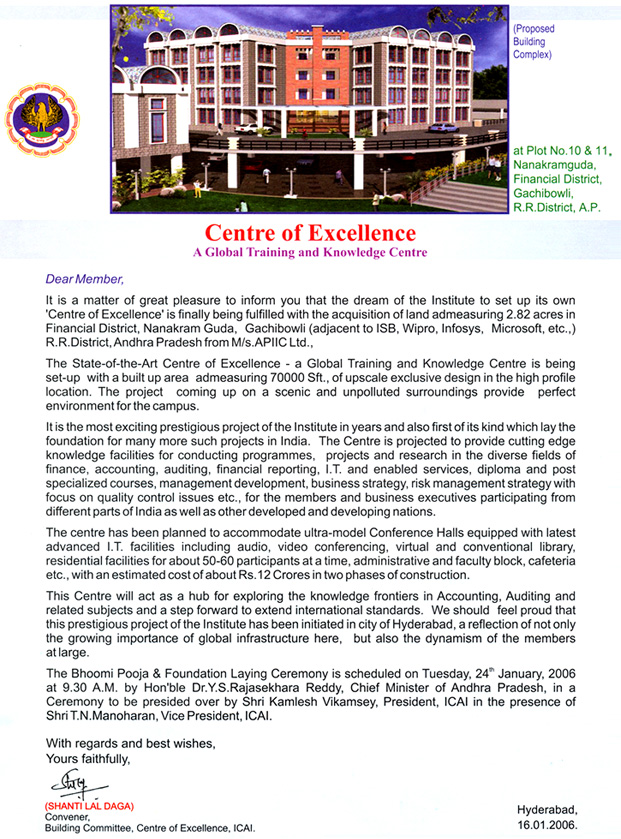
November 15th, 2010
The article starts as follows:
The Harvard-educated home minister P. Chidambaram could learn some valuable lessons at this campus located in the heart of the Naxalinfested tribal district of Gajapati in Orissa, bordering Andhra Pradesh. Centurion School of Rural Enterprise Management (csrem) is run by two management professors – Mukthi Mishra and D.N. Rao – who quit their jobs at Xavier Institute of Management Bhubaneswar (ximb) to set up their own B-school barely seven years ago. They have made a tremendous impact in this poor and restive region. “Over the past few years, we have managed to produce over 10,000 graduates in engineering and management, and vocational certificate holders in a range of trades from the region,” says Mishra, co-founder of csrem.
Following is a scan of the whole article.
.jpg)
November 13th, 2010
Following are excerpts from the interview at http://www.livemint.com/richardlevin.htm.
Leading Indian institutes are good at teaching but they are not research-oriented. What should be the focus now?
The IITs and IIMs are basically good teaching institutions… The biggest contribution made by research universities is that they have advanced knowledge as well as educate quality students. The requisite for making that happen is, one, opening up the structure of faculty compensation so that you can actually attract world-class individuals.
The strong Indian nationals go to graduate schools in the US and they will not come back if they don’t get compensation close to what they get aboard. And right now, they would not unless there is some change in legislation.
The second is the state support—the need for quality laboratory, infrastructure and competitive research grant to advance their work. While there have been some advances in research grants in India, there is still by and large not the quality of the facility that you can have access to in the US, parts of Europe or indeed recently in China.
…
You had an interaction with Ratan Tata (chairman of Tata group). Is he sponsoring a chair?
There is nothing particular to announce now. We are talking to lots of leading Indian families who are interested in Yale getting more involved in India. I hope there will be some support for our relationship. There is a lot of philanthropic interest in higher education of India. I hope Parliament will open the market up to those philanthropists to build universities. They can give some money to Yale, but that will not have the impact.
India is very brand conscious and it seems it wants foreign universities to set up shop here. That will help, but that is not the answer. The answer is great Indian universities and Indian brands. You have done it with companies—you got Tata, Reliance (Reliance Industries Ltd and Reliance-Anil Dhirubhai Ambani Group), Infosys (Technologies Ltd), you got Wipro (Ltd). These are great global brands now. You can do the same with Indian universities rather than co-branding like Yale-India Campus or Harvard-India Campus.
The impression here is Yale is interested in partnering one or more of the proposed innovation universities. Is that true?
We can have partnership in more than one area (but) not as co-brands. There will be some exchanges.
We may have some advisory role, having some of our faculty helping establish these universities. No joint investment. I think the real hope (for innovation university) is private sector support.
How do you see the growth of education in India vis-à-vis China?
… To compete successfully 20 years from now, India and China will need much stronger research universities. China is very aware of this and politically committed to it.
China is making big investments in research laboratories. They are putting lots of money in top universities to make them competitive with Harvard, Yale and Stanford. They are focusing more on a small number of top universities. Politically, that is very hard for India to do because of India’s democracy. It is very hard for America to do so. Solution is to allow the private sector to have a big role in higher education.
I believe you will succeed because India has built great companies in (the) last 20 years. I think a lot of people responsible for that want to give back to the Indian society. They are eager to do what Leland Stanford (founder of Stanford University) and John D. Rockefeller (founder of Chicago University and Rockefeller University) did in America over 100 years ago. If I am not mistaken, all Parliament needs to do is not to give the money away but pass legislation so that will happen.
The term Ivy League seems to have caught on. After China branded some of its university as C-9 or the Chinese Ivy League, India is set to designate at least nine top universities the Indian Ivy League. Does this help?
It reflected something really in China. Those are the universities that China is making disproportionate investment (in). In fact the government made those investments before naming them as Ivy League of China. I don’t know much about the Indian Ivy League. Unless there are much resources, I don’t think it will have that much of impact.
… prashant.n@livemint.com
I have underlined the part that I thought are important. President (of Yale) Levin is right in his answers. Under the current system Indian government can not pay large enough compensations that will attract a large number of top-quality Ph.Ds and faculty from abroad to populate proposed world class research and innovations universities in India. Only private universities backed by Billion dollar level endowment as well as a viable plan to have global level annual funding year after year (note: My university, Arizona State U, has an annual budget of $1.7 Billion plus; Harvard and Stanford annual budgets are about $3 Billion) have a chance to become world class. Fortunately Vedanta University is exactly such a plan. But unfortunately, the Indian government, instead of helping it and showcasing it such that other billionaires from India follow it, is creating hurdles.
November 13th, 2010
Following is from an article in tathay.in.
The proposed Xavier University in Odisha seems to be pushed inside the deep fridge.
Chief Minister Naveen Patnaik eagerly approved the proposed Xavier University in the state in July, 2009.
Thanks to the initiative of Fr.P T Joseph, Director XIMB who brought the issue to the authorities in the Odisha Government about the requirement of Xavier University in the state.
Ananga Udaya Singh Deo, Minister Planning & Coordination, who raised the issue in the State Cabinet in a strong way, impressed the Chief Minister.
With the green signal of the Chief Minister the authorities in XIMB moved ahead with accquiring land nearby the Capital City and a Detailed Plan for the proposed university was prepared.
Every thing is ready.

So every body expected that the much needed Xavier University Bill will come up in the Winter Session of the Odisha Legislative Assembly.
Now on 23 November, Winter Session of the OLA begins.
However there is no sign of the proposed bill on Xavier varsity, revealed an officer in the Department of Law.
Why is it so?
Officials in the Department of Higher Education reveal that though the Xavier University proposal has been approved by the Chief Minister, no separate bill for the proposed varsity will be presented in the Assembly.
An Umbrella Act is being prepared for all the private and professional universities, which is likely to be tabled in the House.
However legal pundits opine that such an Umbrella Act will not stand scrutiny of law.
That is why the Umbrella Act, which was posed to Department of Law during last August, is yet to be vetted by the legal experts.
Legal luminaries feel that “an Umbrella Act for Universities is bad in eyes of law”.
That is why such an Umbrella Act adopted by the Government of Chhatisgarh was set aside by the Apex Court in recent past.
Educationists feel that “If one does not have the right connections in the Corridors of Power in Odisha, it is impossible to move an inch”.
With no Godfather backing the Xavier Institute of Management, Bhubaneswar (XIMB), the Director Fr. Joseph is running from pillar to post to clear the Xavier University Bill.
However no body knows where the file is gathering dust in the State Secretariat.
This is really unfortunate.
November 11th, 2010
Following is from http://pib.nic.in/release/release.asp?relid=66918.
The civil work for Package I – medical college started at all the sites in last week of May, 2010 and is scheduled to be completed in 15 months except Patna where duration is 18 months. For package II – medical college, work started in the middle of September, 2010 and it is scheduled to be completed in 24 months from commencement of work. The civil work at all the six sites is at various stages.
At Rishikesh, the provision of basement for medical college has been deleted due to high water level during excavation. Consequently, structural analysis has been re-done and designs was got revised by the Design DPR consultant. At Bhubaneswar, there was resistance from local people for mobilization of activities of the contractor. As such, the work at Rishikesh and Bhubaneswar site are slightly behind the schedule.
An amount of Rs.622.37 Crore for construction of medical colleges and an amount of Rs.1330.71 Crore for hospital complex in respect of all the six sites were allocated. Mobilization advance of 5% has so far been released.
Out of 13 institutions, 10 institutions involve both civil work and procurement of medical equipment and the remaining 3 involve mainly procurement of equipment. Civil work at 4 medical colleges, viz. Trivandrum Medical College, Bangalore Medical College, Salem Medical College and Sanjay Gandhi Postgraduate Institute of Medical Sciences, Lucknow has been completed. The work at Nizam Institute of Medical Sciences, Hyderabad; Jammu Medical College and OPD and Academic Block of Kolkata Medical College is likely to be completed by December, 2010 and remaining 3 institutions in 2011.
Procurement of medical equipments for all the 13 medical college is expected to be completed by March, 2011.
This information was given by Minister for Health and Family Welfare Shri Ghulam Nabi Azad in written reply to a question raised in Rajya Sabha today.
November 10th, 2010
Following is from http://pib.nic.in/release/release.asp?relid=66896.
The National Development Council has approved the setting up of fourteen Universities aiming at world class standards and dedicated to innovation. These universities are proposed to be located at Bhubaneswar in Orissa, Kochi in Kerala, Amritsar in Punjab, Greater Noida in Uttar Prdesh, Patna in Bihar, Guwahati in Assam, Kolkata in West Bengal, Bhopal in Madhya Pradesh, Gandhinagar in Gujarat, Coimbatore in Tamilnadu, Mysore in Karnataka, Pune in Maharashtra, Vishakhapatnam in Andhra Pradesh and Jaipur in Rajasthan respectively.
A concept paper finalized by the government is available on website www.education.nic.in and includes the scope for public private partnership.
The proposed universities for innovation are to be established across two plan periods of XIth and XIIth Plan.
This information was given by the Minister of Human Resource Development Shri Kapil Sibal, in a written reply to a question in the Lok Sabha today.
It was not clear to be what the National Development Council is. Searching in the web I came across the following:
The Planning Commission works under the overall guidance of the National Development Council, India’s prime policy-making body, which guides the nation on the development process.
The planning commission page http://planningcommission.nic.in/plans/planbody.html has the speeches of the PM and CM of various states in various National Development Council meetings. In the most recent meeting the PM addresses his cabinet colleagues, the CM and ministers from various state delegations, and the planning commission members.
November 10th, 2010
Following is from the PIB release http://pib.nic.in/release/release.asp?relid=66858.
A proposal was received from the Ministry of Youth Affairs & Sports to convert Rajiv Gandhi National Institute for Youth Development, an institution deemed to be university, at Sriperumbudur into Rajiv Gandhi Central University/National Institute of Youth and Sports. In order to examine the proposal and to make suitable recommendations, the Government has constituted a Committee …
In the past we have suggested a similar institution in Rourkela, the cradle of Hockey in Odisha and India.
Following is from another PIB release http://www.pib.nic.in/release/release.asp?relid=66771. (Thanks to kalahandia.blogspot.com for the pointer.)
The Union Cabinet today approved the establishment of a National Centre for Molecular Materials (NCMM) at Thiruvananthapuram in Kerala as an autonomous institute of the Government of India (GOI) under the Department of Science & Technology (DST) at a total cost of ` 76.7 crore for five years with an outlay of ` 14.55 crore for the Eleventh Plan Period.
The Centre will be located on 40 acres of land provided by the State Government, free of cost.
The Centre will be the first of its kind in the country and will pursue high-end science and develop technology in niche areas like sensors for biomedical devices, materials for solar energy harvesting and space electronics. Through the Centre, the Government attempts to create a national innovation infrastructure that channels knowledge systems to wealth creation in the long run.
The Centre will collaborate with other academic institutions and actively interact with industry and user groups. It will generate human resources in the form of well-qualified researchers, technicians and entrepreneurs who can help develop the use of such materials for technological applications and exploit the market potential in this area.
For long Odisha has been trying for a research center on materials along similar lines, but without much success.
November 9th, 2010
Following is an excerpt from a interview in http://chronicle.com/article/Yales-President-Talks-About/125273/.
Q. By "innovation," what do you mean? Could you give me some examples?
A. The biggest one is this: If India is going to build some truly high-quality institutions, it is going to have competitive compensation on a global scale. One of the things the Chinese have done, … they have essentially decided to break their salary scales to recruit back Chinese expats working in the U.S. and U.K. to be leaders and senior professors at their top institutions. And India has an extraordinary expat academic population. But it is very hard to get those people back in the public universities [here], because they are not attractive-enough jobs. So "innovation universities" offer hope that they’ll be able to provide competitive compensation and merit-based compensation.
Q. Did you talk with Kapil Sibal, India’s minister in charge of higher education, about this?
A. Yes, with the minister and many other people here. … The whole point of innovation universities is that both public and private innovation universities in the legislation [to allow for their creation] will have the possibility of not paying [faculty salaries] according to the standard scale.
Q. Why is that issue here in India important to you at Yale?
A. If the question posed to us is, Help us build world-class institutions, my first piece of advice is you can’t do it and pay people 20 percent of what they earn in the U.S. [He laughs.]
The last point is a very important one. While there are many top world class researchers in India, who are only paid 20% of what they would earn in the US, it is not possible to have a university full of such top (in terms of research) faculty by paying them only 20%; let alone have 14 such universities.
That is why there is a need of deep pocketed private benefactors of such universities.
November 9th, 2010
Following is an excerpt from a report in Indian Express.
“To boost innovation in basic sciences, the government is keen on funding and establishing world class institutes. We have recently established more IITs, IISERs and institutes in pharmaceutical science. On the same lines, the Cabinet has decided to establish IIESTs across the country,” said Prithviraj Chavan, Union Minister for State for Science and Technology.
He was inaugurating a seminar on Nano Technology: Materials and Composites for Frontier Applications, organised by Bharati Vidyapeeth University. Chavan did not commit that CoEP would feature on the list of five colleges to be converted into IIESTs, but said there was a possibility because the college has been trying to get deemed university status.
Odisha should remind the central government regarding its earlier request to upgrade VSSUT, Burla to an IIEST.
November 2nd, 2010
Four institutions in Odisha offer this course this year. See the Samaja ad below.
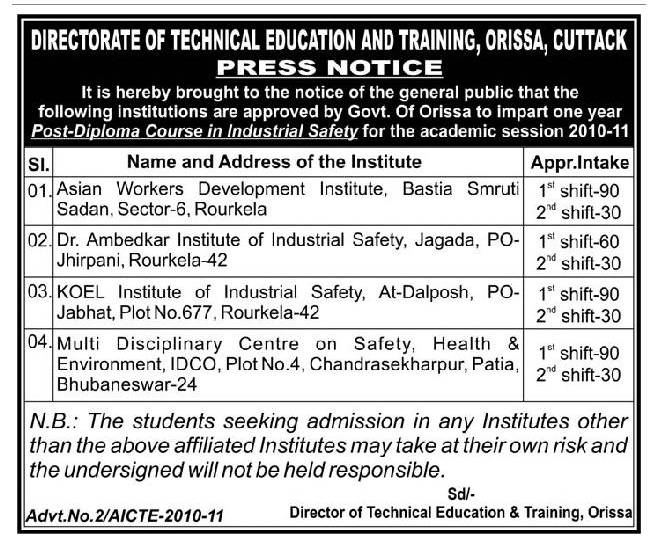
Last year three additional institutes offered this course.

October 31st, 2010
Following is from the face book page of Sri Sri University.

Selected as one of the twenty-five Most Powerful Women in Indian business by ‘Business Today’, India’s premier business magazine, 2008
Ms. Akhila Srinivasan is currently the Managing Director of Shriram Life Insurance Co. Ltd. which is a part of the $7.5 Billion Shriram Group, headquartered in Chennai, India.
Her extraordinary achievements stem from an intense personal philosophy and work ethic that have led her to become one of the key Board Level Executives of the Shriram Group, and the only female Managing Director. She is also among the very few Board Level female executives in the financial services sector in the country.
Ms.Akhila knows the importance of education and hard work; she holds a M.A., M.
Phil Degree in Economics and is currently pursuing her Ph.D.
Following is Sri Sri University’s logo as obtained from the above mentioned facebook page.
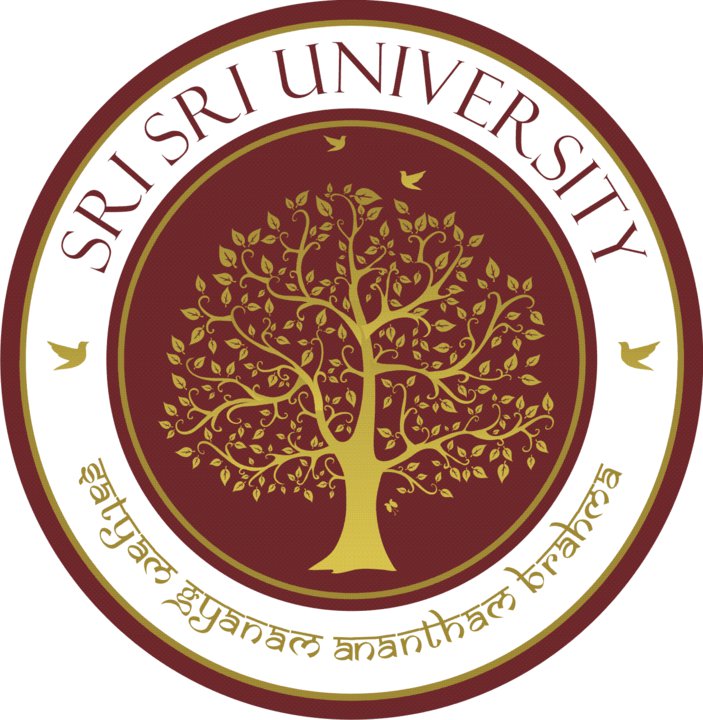
The university will start functioning in 2011 and will admit students in its business program. Following are some design diagrams of its business school taken from its facebook page: Sri Sri University Institute of Management Studies.
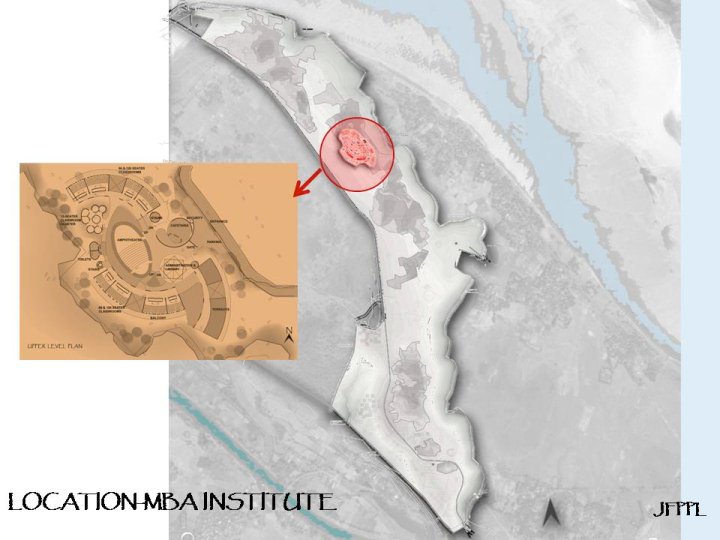
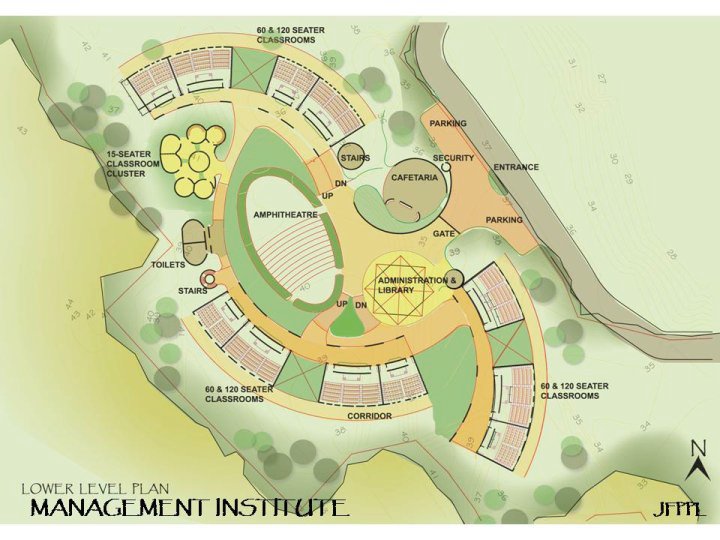
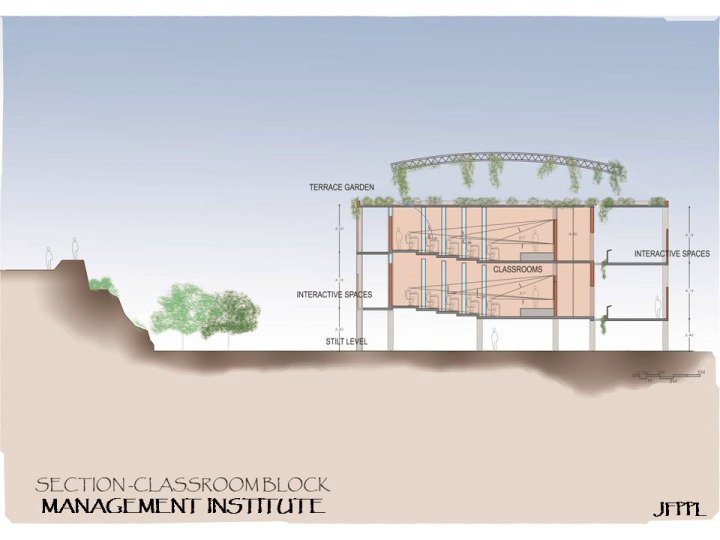

October 31st, 2010
Following is an excerpt from a report in expressindia.com.
Yale president Richard Levin on Thursday said that while China had worked on a “dramatic scale of advancement” in the education sector in the last decade, India has only now begun to work on that path. Speaking to The Indian Express after signing an MoU to launch the “India-Yale University Leadership Programme” with IIT Kanpur and IIM Kozhikode, Levin said India’s answer to China’s investment in high quality education was innovation.
“Making the advancement that China has made…that’s expensive. China has put in a lot of money in higher education… China has singled out 10 per cent of its national universities towards disproportionate investment in order to make them globally competitive,” Levin said. He added that India being a very democratic nation could not, on the other hand, single out certain institutes and provide them with funds in order to make them compete with the Ivy League. China has developed nine of its top universities in a way that they can compete with the US Ivy league.
“Whereas for India, which is a much more democratic country, it is harder to make those kinds of distinctions with government funds and say …we are going to take these five institutions and make them competitive with Yale, China is doing it and getting away with it. India’s answer is innovation universities and have the private sector raise extra resources to get really high quality institutions. That I think for India is a very adaptive strategy,” he said.
… The combination of opening to foreign universities, creating innovation varsities, reforming the accreditation — all of these I think will help for talent advance in higher education sector in India. I am very supportive of Mr Sibal’s vision and hope he is successful in his legislative agenda,” he said.
He, however, admitted that there were misgivings about ‘bureaucratic barriers” in India and that to attract foreign universities to India they would have to be allowed to set their own pay scales, promote/ advance people on their own criteria and bring students they approve by their own process.
October 30th, 2010
Next Posts
Previous Posts

.jpg)








